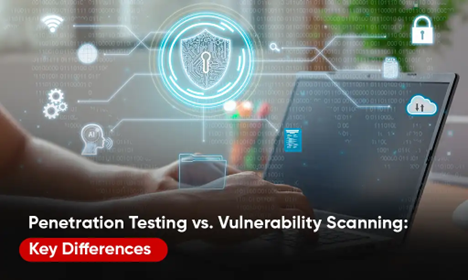This article delves into their key differences, helping businesses understand when and why each method is necessary to strengthen their security posture.
Cybersecurity is essential for businesses today, and identifying system weaknesses before they can be exploited is crucial. Two commonly used methods for this purpose are penetration testing and vulnerability scanning. Although both aim to improve security, they differ in how they work, their scope, and what they reveal. By understanding the differences, businesses can make more informed decisions about when to use each technique.
What is Vulnerability Scanning?
Vulnerability scanning is a process that identifies known security issues within a system. It works by scanning networks, applications, or other systems for weaknesses, comparing the findings against a database of known vulnerabilities. Popular tools like Nessus, OpenVAS, and Qualys are often used for this purpose.
How It Works:
Vulnerability scanners search for outdated software versions, missing patches, open ports, misconfigurations, and other vulnerabilities. After the scan, the tool provides a report that details the weaknesses found, along with their severity.
Purpose:
The main goal of vulnerability scanning is to proactively identify security risks and fix them before attackers can exploit them. It is an ongoing process since new vulnerabilities can appear regularly due to software updates or new threats.
Advantages of Vulnerability Scanning:
1. Automation: These tools can automatically scan a large number of systems with minimal intervention.
2. Regular Checks: Vulnerability scans can be performed frequently, ensuring systems are up-to-date with the latest patches.
3. Affordable: Vulnerability scanning is typically a cost-effective way to monitor system security.
Limitations of Vulnerability Scanning:
1. False Positives: Automated tools might flag vulnerabilities that aren’t actually a threat or don’t have a significant impact.
2. Limited Insight: Vulnerability scanners often miss potential risks that can only be exploited under specific conditions.
What is Penetration Testing?
Penetration testing, also known as ethical hacking, is a process where a security expert simulates a cyberattack to identify and exploit weaknesses within a system. Unlike vulnerability scanning, which simply identifies known vulnerabilities, penetration testing tries to exploit those vulnerabilities to see how far an attacker could go.
How It Works:
Penetration testers use various techniques and tools to mimic the behavior of cybercriminals. They attempt to bypass security controls, gain unauthorized access, escalate privileges, and access sensitive data.
Purpose:
Penetration testing’s goal is to simulate a real-world attack, helping organizations understand how their systems would hold up against a hacker. It gives businesses a more accurate picture of the security risks they face.
Advantages of Penetration Testing:
1. Real-World Simulation: This method provides a realistic understanding of how vulnerabilities might be exploited by actual attackers.
2. In-Depth Analysis: Penetration testing looks deeper into systems, identifying hidden threats that scanning tools may miss.
3. Targeted Testing: It allows organizations to focus on high-value assets, such as sensitive data or critical infrastructure.
Limitations of Penetration Testing:
1. Time-Consuming: Penetration tests take time to perform, often requiring days or even weeks.
2. Expensive: Due to the expertise required and the amount of time involved, penetration testing can be costly.
3. One-Time Assessment: Penetration testing provides a snapshot of a system’s security at a specific moment, but it does not offer ongoing monitoring.
Key Differences Between Penetration Testing and Vulnerability Scanning
Now that we understand what each method involves, let’s look at the main differences between penetration testing and vulnerability scanning. Understanding these differences will help you determine which method to use and when.
1. Approach and Methodology
Vulnerability scanning is an automated, passive process that identifies known vulnerabilities based on predefined rules. It is a routine, preventative measure aimed at identifying risks regularly. Penetration testing, however, is a manual, active process where a security expert attempts to exploit vulnerabilities in the same way a hacker would.
2. Frequency
Vulnerability scans can be run frequently sometimes daily or weekly depending on the system’s needs. Penetration tests are typically done less often, usually once or twice a year, due to the resources and time required.
3. Scope
Vulnerability scanning aims to cover as many systems as possible to give a broad view of potential risks. Penetration testing, in contrast, is often more targeted. It might focus on specific areas, such as critical infrastructure or sensitive data, to simulate a specific type of attack.
4. Depth of Analysis
Vulnerability scanning provides a high-level overview of known security flaws. While it can identify potential threats, it doesn’t test how those vulnerabilities could be exploited. Penetration testing goes deeper, trying to exploit vulnerabilities and assess the real-world consequences of a successful attack.
5. Outcomes and Reporting
The report from a vulnerability scan typically lists vulnerabilities along with their severity and potential fixes. Penetration testing reports are more detailed and often include how an attacker could exploit identified vulnerabilities and what measures can be taken to prevent such attacks.
6. Cost
Because of the expertise required and the amount of time involved, penetration testing is generally more expensive than vulnerability scanning. Vulnerability scanning is an affordable option for regular monitoring, whereas penetration testing is more of an investment in a thorough, one-time assessment.
When to Use Vulnerability Scanning vs. Penetration Testing
Both vulnerability scanning and penetration testing have their place in a comprehensive cybersecurity strategy, but knowing when to use each can make a significant difference.
Vulnerability Scanning
Use vulnerability scanning regularly as part of your ongoing cybersecurity strategy. It is especially useful for organizations with large IT infrastructures, as it helps ensure that all systems are continually monitored for vulnerabilities. Vulnerability scanning is great for quickly identifying and patching known security flaws before they can be exploited.
Penetration Testing
Penetration testing is best used periodically, especially after major system changes or updates. It should also be done after implementing new systems or when you’re concerned about specific high-value assets being targeted. This method provides a detailed understanding of the real-world risks and can help you improve your defenses.
Combining Penetration Testing and Vulnerability Scanning for Maximum Security
While both vulnerability scanning and penetration testing are important, combining them provides a more robust approach to cybersecurity. Vulnerability scanning offers regular, automated checks for common weaknesses, while penetration testing digs deeper to simulate real-world attacks and assess the true effectiveness of your defenses. By using both methods together, organizations can stay ahead of potential threats and strengthen their overall security posture.
Conclusion
Penetration testing and vulnerability scanning are both essential techniques for identifying and addressing security vulnerabilities, but they serve different purposes. Vulnerability scanning offers regular, automated checks to detect known risks, while penetration testing simulates real-world attacks to help organizations understand the potential consequences of those risks. By using both methods effectively, businesses can ensure their systems are secure and well-prepared for whatever threats may come their way.






Comments